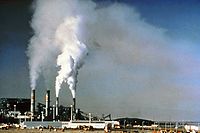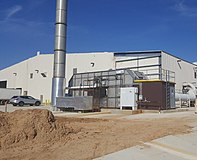- Toxic metals, such as lead and mercury, especially their compounds.
- Chlorofluorocarbons (CFCs): Emitted from goods that are now prohibited from use; harmful to the ozone layer. These are gases emitted by air conditioners, freezers, aerosol sprays, and other similar devices. CFCs reach the stratosphere after being released into the atmosphere. They interact with other gases here, causing harm to the ozone layer. UV rays are able to reach the earth’s surface as a result of this. This can result in skin cancer, eye problems, and even plant damage.
- Ammonia: Emitted mainly by agricultural waste. Ammonia is a compound with the formula NH3. It is normally encountered as a gas with a characteristic pungent odor. Ammonia contributes significantly to the nutritional needs of terrestrial organisms by serving as a precursor to foodstuffs and fertilizers. Ammonia, either directly or indirectly, is also a building block for the synthesis of many pharmaceuticals. Although in wide use, ammonia is both caustic and hazardous. In the atmosphere, ammonia reacts with oxides of nitrogen and sulfur to form secondary particles.
- Odors: Such as from garbage, sewage, and industrial processes.
- Radioactive pollutants: Produced by nuclear explosions, nuclear events, war explosives, and natural processes such as the radioactive decay of radon.
- Polycyclic Aromatic Hydrocarbons (PAHs): a group of aromatic compounds formed from the incomplete combustion of organic compounds including coal and oil and tobacco.
Secondary pollutants include:
- Photochemical smog: particles are formed from gaseous primary contaminants and chemicals. Smog is a type of pollution that occurs in the atmosphere. Smog is caused by a huge volume of coal being burned in a certain region, resulting in a mixture of smoke and sulphur dioxide. Modern smog is usually caused by automotive and industrial emissions, which are acted on in the atmosphere by UV light from the sun to produce secondary pollutants, which then combine with the primary emissions to generate photochemical smog.
- Ground level ozone (O3): Ozone is created when NOx and VOCs mix. It is a significant part of the troposphere. It’s also an important part of the ozone layer, which can be found in different sections of the stratosphere. Photochemical and chemical reactions involving it fuel many of the chemical activities that occur in the atmosphere during the day and night. It is a pollutant and a component of smog that is produced in large quantities as a result of human activities (mostly the combustion of fossil fuels).
- Peroxyacetyl nitrate (C2H3NO5): similarly formed from NOx and VOCs.

Minor air pollutants include:
- A large number of minor hazardous air pollutants. Some of these are regulated in USA under the Clean Air Act and in Europe under the Air Framework Directive.
- A variety of persistent organic pollutants, which can attach to particulates
Persistent organic pollutants are organic compounds that are resistant to environmental degradation due to chemical, biological, or photolytic processes (POPs). As a result, they’ve been discovered to survive in the environment, be capable of long-range transmission, bioaccumulate in human and animal tissue, biomagnify in food chains, and pose a major threat to human health and the ecosystem.
| To display all pages, subcategories and images click on the “►”: |
|---|
| Hazardous air pollutants (4 C, 68 P) |

